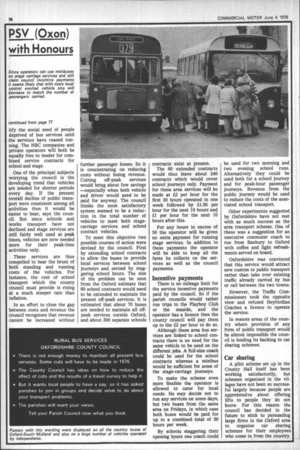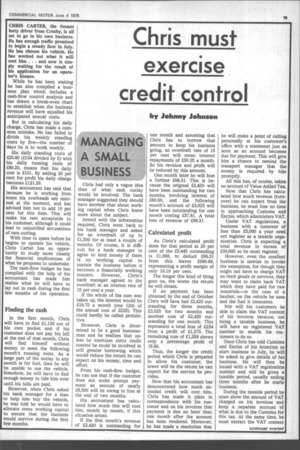PSV (Oxon) with Honours
Page 80

Page 81

If you've noticed an error in this article please click here to report it so we can fix it.
Since operators can use minibuses on stage carriage services and still claim council incentive payments it seems likely that with more local control exerted vehicle size will decrease to match the number of passengers carried.
continued from page 77
tify the social need of people deprived of bus services until the services have ceased running. The NBC companies and private operators will both be equally free to tender for combined service contracts for school and stage.
One of the principal subjects worrying the council is the developing trend that vehicles are needed for shorter periods every day. If the present overall decline of public transport were consistent among all activities then it would be easier to bear, says the council. But since schools and works transport have not declined and stage services are still fairly well used at peak times, vehicles are now needed more for their peak-time activities only.
These services are thus compelled to bear the brunt of both standing and running costs of the vehicles. For instance, the cost of school transport which the county council must provide is rising at a much steeper rate than inflation.
In an effort to close the gap between costs and revenue the council recognises that revenue cannot be increased without further passenger losses. So it is concentrating on reducing costs without losing revenue. Cutting off-peak services would bring about few savings —especially when both vehicle and driver would need to be paid for anyway. The council thinks the most satisfactory system seemed to be a reduction in the total number of vehicles to meet both stagecarriage services and school contract vehicles.
To meet this objective two possible courses of action were devised by the council. First by extending school contracts to allow the buses to provide local services between school journeys and second by staggering school hours. The size of the problem can be seen from the Oxford estimate that 60 school contracts would need to be extended to maintain the present off-peak services. It is estimated that about 70 buses are needed to maintain all offpeak services outside Oxford, and about 300 separate schools contracts exist at present.
The 60 extended contracts would thus leave about 240 contracts which would cover school journeys only. Payment for these area services will be made at £2 per hour for the first 30 hours operated in one week followed by £1.50 per hour for the next 10 hours and £1 per hour for the next 10 hours after this.
For any hours in excess of 50 the operator will be given no extra payment for running stage services. In addition to these payments the operator will be able to keep all the fares he collects on the services as well as the council payments.
Incentive payments
There is no mileage limit for the service incentive payments paid by the council. So if the parish councils would rather run trips to the Playboy Club or the seaside, and the operator has a licence then the county council will pay them up to the £2 per hour to do so.
Although these area bus services are linked to school contracts there is no need for the same vehicle to be used on the different jobs. A full-size coach could be used for the school contracts whereas a minibus would be sufficient for some of the stage-carriage journeys.
To make the scheme even more flexible the operator is allowed to cater for local needs. He may decide not to run any services on some days, but two buses from the same area on Fridays, in which case both buses would be paid for up to a combined total of 50 hours per week.
By schools staggering their opening hours one coach could be used for two morning and two evening school runs. Alternatively they could be used both for a school journey and for peak-hour passenger journeys. Revenue from the public journey would be used to reduce the costs of the associated school transport.
Other experiments suggested by Oxfordshire have not met with as much success as the area transport scheme. One of these was a suggestion for an executive commuter coach to run from Banbury to Oxford with coffee and light refreshments served on board.
Oxfordshire was convinced that this service would attract new custom to public transport rather than take over existing traffic already carried by bus or rail between the two towns.
However, the Traffic Commissioners took the opposite view and refused Heyfordian Coaches a licence to operate the service.
In remote areas of the country where provision of any form of public transport would be almost impossible the council is lending its backing to car sharing schemes.
Car sharing
A pilot scheme set up in the County Hall itself has been working satisfactorily, but schemes organised in the villages have not been so successful largely because people are apprehensive about offering lifts to people they do not know. For this reason the council has decided in the future to stick to persuading large firms in the Oxford area to organise car sharing schemes for their employees who come in from the country. CHRIS CARTER, the former lorry driver from Crosby, is all set to go in his own business. He has enough traffic promised to begin a steady flow in July. He has chosen his vehicle. He has worked out what it will cost him . . . and now is simply waiting for the result of his application for an operator's licence.
While he has been waiting he has also compiled a business plan which includes a cash-flow control analysis and has drawn a break-even chart to establish when the business revenue will have equalled his anticipated annual costs.
But in calculating his daily charge, Chris has made a common mistake. He has failed to divide his weekly standing costs by five—the number of days he is to work weekly.
His daily standing costs of £20.80 (£104 divided by 5) with his daily running costs of £80.20, means that his daily cost is £101. By adding 20 per cent for profit his daily charge becomes £121.20.
His accountant has said that because he is working from home his overheads are minimal at the moment, and has advised him not to add 10 per cent for this item. This will make his rate acceptable to his customer, although it could lead to unjustified accusations of rate cutting.
With time to spare before he begins to operate his vehicle, Chris Carter has an opportunity to study more closely the financial implications of what he proposes to undertake.
The cash-flow budget he has compiled with the help of his accountant has made him realise what he will have to lay out in cash during the first few months of his operation.
Finding the cash
In the first month, Chris will have to find £1,138 out of his own pocket and if his customer does not pay his bill at the end of that month, Chris will find himself without money to meet the following month's running costs. As a large part of the outlay in any month is for fuel, then he will be unable to use the vehicle. Somehow, he will have to find enough money to tide him over until his bills are paid.
However, when Chris asked his bank manager for a loan to help him buy the vehicle, he was told he would have to allocate some working capital to ensure that the business would survive during the first few months.




























































































































